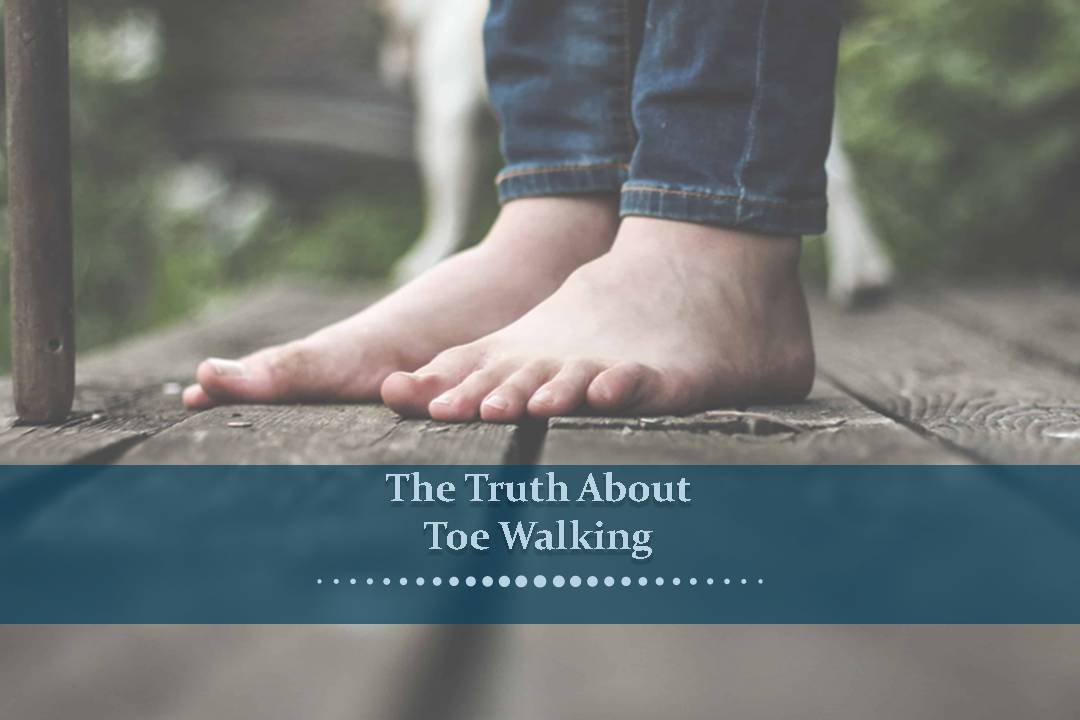Children walking on their toes is not uncommon, however it may be indicative of an underlying issue. While many people think toe-walking is specific to autism, it’s actually commonly related to sensory or muscular issues, and it can have long-term health effects. But there are ways to help your child, and we’ve got all the info you want!
Table of Contents
- What is Toe Walking?
- Why Does My Child Toe Walk?
- Should I Be Concerned About My Child Toe-Walking?
- Medical Conditions From Toe Walking
- What Do I Do if My Child Does Not Outgrow the Toe-Walking?
What is Toe Walking?
John Hopkins Medicine describes toe walking as: Toe walking is the pattern in which a child coordinates their step to place the foot down first on the ball of the feet. When toe walking occurs, contact between the heel and the ground does not occur. A common walking pattern is first pressing the heel to the floor. The second movement the foot rolls forward onto the ball of the feet. In toe walking, heel contact with the floor is omitted. The initial step is a solid strike to the floor on the ball of the foot.
Why Does My Child Toe Walk?
Toe walking can occur for a variety of reasons. The first possible reason is sensory related. Some children are hypersensitive to particular textures and/or surfaces on the ground. Children find uncomfortable textures as textured surfaces such as wood floors, gravel or carpeting. This causes children to be more prone to walk on their toes.
Conversely, children who toe walk may also be seeking extrasensory input. Young ones seeking more sensory input can do so by walking on their toes. During toe walking the knees and ankles are typically locked and muscles have increased tension. The walking pattern performed during toe walking provides increased sensory input to joints, such as the knees and ankles.
Should I Be Concerned About My Child Toe-Walking?
Many kids toe-walk and the reason can be considered idiopathic. Idiopathic toe-walking means there is no known reason, and the child does not have any other medical diagnosis that would cause the child to walk this way. Children may just prefer to walk on their toes, and continue persistent toe walking out of habit. Kids without underlying diagnosis or sensory issues practice idiopathic toe walking. Naturally, some children with idiopathic toe walking can walk flat footed when asked, or they may not walk on their toes at all when wearing shoes. It is most pronounced when walking bare-footed from room to room, or when walking on carpet, tile or grass.
Be sure to have your child evaluated by a physician. While it doesn’t readily seem dangerous, toe walking can lead to problems over time. After the age of 2, however, most children outgrow toe walking and begin to walk with a normal heel-to-toe pattern.
Medical Conditions From Toe Walking
Another primary reason children may toe walk is because of an undiagnosed illness. In rare cases, continuing to toe walk after age 2 may be the sign of an underlying medical condition.
Some diagnoses like muscular dystrophy are medical conditions that may spur toe walking in children. The muscle is destroyed and gradually replaced with fat through muscular dystrophy. The calf muscles are typically the first to suffer. The lack of muscle from a disorder, such as muscular dystrophy, may encourage toe walking because of decreased muscle strength. It is widely asserted that most conditions which result in abnormal increases in muscle tone will result in toe walking, like cerebral palsy. Those with cerebral palsy may exhibit unsteady walking, including toe walking. Their muscles also may be very stiff.
Doctors have also observed a higher incidence of toe walking in those with autism spectrum disorders. However, doctors haven’t pinpointed exactly why those with autism may be more likely to toe walk. Toe walking by itself is not a sign of autism. Sometimes children with autism-related conditions actually have sensory related reasons, as we previously stated.
Children who regularly toe walk, can develop tight Achilles’ tendons in older age. If your child has developed excessive tightness, then it is a contracture. If contracture occurs, dropping the heel to the ground may become impossible. Tightened tendons also lead to problems in proper alignment of the feet and legs. The misaligned feet and legs ultimately contribute to flat arches, or outwardly rotated legs. Outwardly rotated legs are when heels are placed on the ground.
What Do I Do if My Child Does Not Outgrow the Toe-Walking?
Bracing
Children who have developed excessive tightness in the muscles and tendons may benefit from wearing a brace. Wearing an ankle-foot orthosis (AFO) brace can help stretch and lengthen muscles and tendons in the calf. An AFO is a custom brace that helps stretch and encourage a flat foot position. This brace is typically used during the day time, but can also be worn at night. This improves the stretch of tight muscles while a child is sleeping. Short term walking casts are helpful for one to two week intervals to improve the position of the feet and ankles.
Occupational Therapy & Physical Therapy
Much like adults, children can benefit from occupational therapy and physical therapy. Therapy can assist in teaching appropriate walking and stretching patterns to contribute to decreased toe walking. Occupational therapy can also help your child develop sensory processing and integration skills to help mitigate toe walking. The key to helping kids with toe walking is staying persistent and consistent. It can be a long journey, but the joy at the end will make it all worth it. You and your little one can do weight bearing activities on various textured pads or platforms, sensory integration work, or active range of motion activities to help! As your kids shift their weight to stay balanced, they’ll experience an active stretch in their affected muscles, while playing with you!
For more tips and professional help, contact Greater Learning LP. Our staff includes passionate, dedicated, occupational therapists. We’re here for you and your family in your journey toward healthier living.
Visit www.greaterlearninglp.com or call 210.349.1415 to meet with an occupational therapist and start investing in the future today.


I walk on my toes and I am really concerned. This made me feel much better!